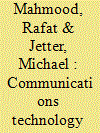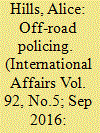| Srl | Item |
| 1 |
ID:
173768


|
|
|
|
|
| Summary/Abstract |
By facilitating the flow of information in society, communications technology (CT; e.g., newspapers, radio, television, the Internet) can help terrorists to (i) spread their message, (ii) recruit followers, and (iii) coordinate among group members. However, CT also facilitates monitoring and arresting terrorists. This article formulates the hypothesis that a society’s level of CT is systematically related to terrorism. We introduce a simple theoretical framework, suggesting that terrorism first becomes more attractive with a rise in CT, but then decreases, following an inverted U shape. Accessing data for 199 countries from 1970 to 2014, we find evidence consistent with these predictions: terrorism peaks at intermediate ranges of CT and corresponding magnitudes are sizable. Our estimations control for a range of potentially confounding factors, as well as country fixed effects and year fixed effects. Results are robust to a battery of alternative specifications and placebo regressions. We find no evidence of a potential reporting bias explaining our findings.
|
|
|
|
|
|
|
|
|
|
|
|
|
|
|
|
| 2 |
ID:
052835


|
|
|
|
|
| Publication |
Autumn-Winter 2003.
|
|
|
|
|
|
|
|
|
|
|
|
|
|
|
|
| 3 |
ID:
148454


|
|
|
|
|
| Summary/Abstract |
Prompted by the trend to see information and communications technology (ICT) as a tool for capacity building, this article asks whether the use of ICT has—or can—recast centre–periphery relations in a hybrid country such as Somaliland. Taking as its departure point Herbst's observation that a fundamental problem confronting African leaders concerns how to extend or consolidate authority over sparsely settled lands, it uses recent developments in Somaliland's coast guard and immigration police to assess ICT's contribution to changing security provision in remote and coastal areas. This allows for an analysis of Somaliland's law enforcement framework, the relationship between its politics and practice, the practical application of its coercive resources, and the Silanyo government's priorities and preference for consensus and co-existence whenever security imperatives allow. It suggests that ICT can be a desirable operational tool or a variable in existing power networks, but that it does not represent a new mode of security governance. ICT's potential to connect Somaliland's government and populace, and politics and practice, is for now minimal, but identifying the ways in which security actors such as coast guards actually use ICT allows for a more accurate assessment of the variables shaping centre–periphery relations. Contrary to Herbst's observation, the Silanyo government does not need to overtly or systematically extend, consolidate or exert its authority in remote and coastal areas. Spatial metaphors such as centre–periphery help to clarify the situation, but the significance invested in them reflects western rationalities, rather than Somali realities.
|
|
|
|
|
|
|
|
|
|
|
|
|
|
|
|
| 4 |
ID:
057446


|
|
|